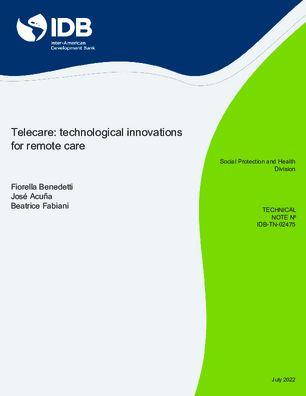Telecare: Technological Innovations for Remote Care
Date issued
Jul 2022
Subject
Telemedicine;
Elderly;
Health;
Emergency Management;
Population Aging;
Science and Technology
JEL code
J14 - Economics of the Elderly • Economics of the Handicapped • Non-Labor Market Discrimination;
J18 - Public Policy;
O33 - Technological Change: Choices and Consequences • Diffusion Processes;
O54 - Latin America • Caribbean
Category
Technical Notes
Telecare is a remote care service that has flourished in recent years because of the many benefits it offers to users, their caregivers, and the health and social services system as a whole. In Europe, the penetration rate of telecare among people older than 65 ranges from below 3% to 11%. In Latin America and the Caribbean, available telecare does not yet meet the existing need for care services, and the region lacks studies that provide a broad perspective on the services potential impact on the region. In this report, we explore the main characteristics and challenges for telecare services and summarize available evidence about its many benefits and potential savings for health and social services systems. The report also compiles regional telecare prices and concludes that the service costs an average of 25 USD a month, which is lower than other care services. This report details the progress that various countries in Latin America and the Caribbean (Argentina, Barbados, Brazil, Chile, Colombia, Costa Rica, Cuba, Mexico, Peru, and Uruguay), Europe, and Asia have made in using this service and gives simple steps for a successful rollout.



